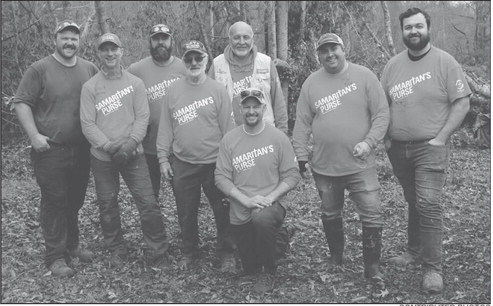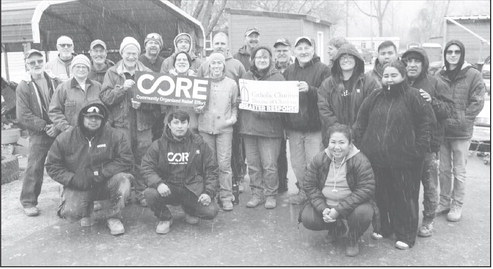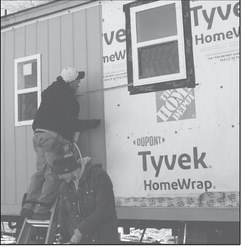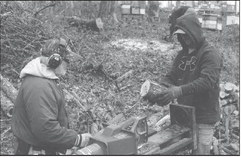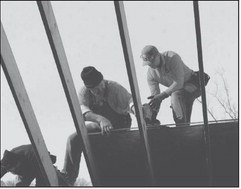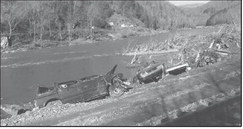Volunteer group sees devastation, hope in trip to help Hurricane Helene victims


By Cheyenne Thomas On Sept. 27, the lives of many people living in North Carolina changed forever. Hurricane Helene made landfall that day, bringing with it destruction and loss for the people living there, particularly in the area around Asheville, which saw significant damage caused by the hurricane, and tornadoes and flooding that followed. Since then, the people living in the area have struggled with living in rough conditions as the cleanup process has been long and slow. However, with the help of volunteers from all over the country, the homes that were lost as a result of the hurricane are being rebuilt one building at a time.
A local group of volunteers recently completed their second trip down to North Carolina to help with the cleanup. In the past two months, groups have left from St. Mary’s Catholic Church in Neillsville to spend a week on each trip cleaning up fallen trees and reconstructing damaged houses. Bob Barth and Earl Elmhorst were two of the members who went down to help on both of the trips, the experience being both fulfilling and much needed for the people of North Carolina.
“It’s addictive,” said Barth. “These people need so much help.”
The first trip down to North Carolina occurred Dec. 7-14. A total of 10 people went, the group being made up of those with carpentry skills and other hands-on building experience to help with repairs. The group split up into two teams on the first trip. Elmhorst went with a group that partnered with Team 222 Disaster Relief, while Barth went with a group that partnered with Samaritan’s Purse. Both groups saw the devastation and talked with survivors of the hurricane, listening to their stories of the challenges they have faced.
“There are some stories that these people would share that would just make you cry if you heard what they went through,” said Elmhorst.
Elmhorst’s team of volunteers first went to the home of a single mother and her two children. When they arrived, Elmhorst said they were living in a camper with no running water, no sewer,
Please see Volunteers, page 3
Soup’s on! The Halopka family of Greenwood enjoys some chili at the Learn-A-Lot Preschool Soup Supper last Wednesday at St. Mary’s Catholic Church in Greenwood. For more photos from the event, see page 24.
VALORIE BRECHT/STAFF PHOTO
from p. 1
and no hot water. By the time they left, all of those things were connected, giving the family some of their basic needs met.
“This place had been flooded,” he said. “She (the single mother) told us that she had to crawl on top of her roof with her 5-year-old daughter and her son. Her daughter fell into the flood waters and her brother, who was probably 10 or 12, didn’t hesitate and just jumped into the water to save her.'
Meanwhile, Barth’s group went out to a home in Spruce Pine, where trees had fallen down on top of a house as a result of tornadoes that swept through the area following the hurricane. They spent a day and a half at the site chopping trees and repairing the roof that had collapsed.
“When we got there, there were tarps flapping in the breeze where they had tried to put them on the roof,” said Barth. “We went into the house and we saw that the ceiling had all fallen in and the roof was destroyed. We had to go in and take all the debris out of the house, tear down the ceiling and take the sheet rock off. We cleaned up all the rooms since they had a ton of water damage and sprayed a bunch of the walls with a mold and mildew solution to prevent any further damage. We fixed the roof, built up the trusses and put sheeting over the top to keep things waterproof until the proper roofing can be installed.”
During the next part of the trip, Barth and Elmhorst’s groups reunited to work on one final project: constructing a 16-foot by 20-foot addition to a home that had a portion torn away as a result of flooding.
“We went down to Green Mountain, which is about 10 minutes away from the Appalachian Trail,” said Elmhorst. “One couple had the addition torn away from their house. The river was way down in the valley below, but it rose up so high that it took the addition right off of their house.”
“They got a lot of water,” added Barth. “There was water coming off the mountains; there was water from the river. It all ate away at the foundation and tore it off.”
Battling the cold and wind, the group of 10 worked over the course of the next few days to restore to the couple what they had lost. It was a lot of work and a challenge to bring up materials to do the repairs, but Elmhorst and Barth said that with determination and a lot of elbow grease, they were able to complete the job.
“In three days we were able to build them a 16-by-20-foot addition on the house,” said Elmhorst. “We worked really hard. The wind would blow things around the yard. There was snow and it was blowing, but we kept working.”
“Our first group was made up of all carpenters or they had some carpentry experience,” said Barth. “Everyone knew what to do and had skills that they could use to help get the job done. You didn’t have to tell any of them what to do.”
In total, on the first trip, the volunteers were able to help out in eight different areas over the course of the week. Besides working on houses, Barth and Elmhorst said a lot of the work they did was to help clear out trees and other debris around homes to make areas passable and allow construction crews to be able to enter into places to make repairs to homes. All the wood that was cut up from the fallen trees, Elmhorst said, was donated to local residents who were using the wood to stay warm. Everywhere they went, the destruction was evident even though months have passed.
“There were cars, railroad cars and semis all washed out off of roads and into ditches and rivers,” said Barth. “There was stuff lying around everywhere in rivers and on roads. The storm wrecked so much. It flooded everything. There was so much destruction. It looks like the storm happened yesterday. There’s still garbage in the trees where the flood waters left them.”
Seeing so much devastation on their first trip, Barth and Elmhorst joined a second group of volunteers from St. Mary’s parish on a trip to North Carolina from Jan. 4-11. On this trip, Barth said 14 volunteers from the area went down in an effort that was coordinated with the Diocese of Charlotte and partnered with Community Organized Relief Effort (CORE) of North Carolina. On this trip, the volunteers made their way down to Swannanoa, to the Alan Compos RV Park where they spent the week working on three homes in the park. These homes, Barth said, were heavily damaged by flooding from the nearby Swannanoa River, which rose overtop its banks and flooded the valley where many of the trailer homes were situated.
“The river rose up 47 feet in some areas,” said Barth. “Where we were working (in the RV park), you couldn’t even see the river, but it came up and flooded all of these places. There were a lot of roads that were washed out.”
To repair the homes that were damaged by the flooding, Barth said they had to essentially strip down the entire home and rebuild it, tearing out insulation, siding, roofing, walls, doors, and other materials that were damaged by the flood waters. Since so much work needed to be done on each home to make it ready to have final inspection so families could live in them again, the progress to repair the homes has
Please see Volunteers, page 8 Volunteers,
from p. 3
been slow, with many local residents still living in campers as they wait to have their homes fixed.
“We were going through and tearing out all the old materials in these homes that were damaged and replacing it with new stuff,” he said. “One of the first houses we worked on was House 51, and we had to add in new doors and trim, new insulation, new siding, new roofing, and new baseboards. When we left, there was very little left to do before it would be inspected and approved to have someone living in it again. The house was owned by a single mom with two children. They were very happy to get back into their home again after four months of living in a camper. There are so many people down there that still need help.”
Part of the issue for many of these residents in North Carolina, Barth said, is how insurance companies are not covering for damages. In so many cases they have seen in the past two trips, he said insurance companies are considering the damages done to homes as flood damage, even when homes are far enough away from a river to never normally be considered for flood damage. This situation leaves behind devastated families who have no other option to fix their destroyed homes besides waiting for the kindness of strangers volunteering their time to help restore their losses.
“A lot of these people are going to struggle to get their homes fixed without volunteer help because while they have insurance, they don’t have flood insurance because they’re nowhere near water,” said Barth. “And the insurance companies will say all the damage was caused by flooding and won’t cover it. A lot of people can’t afford to fix this without that insurance money. So they have to wait for volunteers to help try to rebuild what they lost.”
Since Hurricane Helene, those volunteers have been coming and doing whatever they can to support those who lost everything because of the storm. Whether it was remote help from people who have sent campers to residents so they still have a home to live in, or personal help like the volunteers who have come from all across the country to help, Elmhorst said it has been very inspiring and uplifting to see so many people helping and bonding together in the face of such tragedy.
“This has really brought people together,” he said. “It has been amazing. Even in our church family. It has been very nice to have people bonding and people working together. A lot of guys we talked to said they have had so much joy in helping others. It’s been wonderful. Just going around and seeing people coming from all areas of the U.S. to help out. They just would come in and start working and helping. We saw all sorts of people. There were Cherokee Indians, Mennonites, demolition experts, dump truck drivers from California. It was just unbelievable how many volunteers were out there helping.”
Helping the people of North Carolina is something Barth and Elmhorst feel should be continued. To that end, they are in the process of organizing a third trip down to the state, with plans to continue to help in Swannanoa rebuilding homes. The trip is planned for Feb. 8-15 and they are in the process of recruiting any volunteers who would like to go down and help. If there is anyone who is interested in joining, they are asked to call the St. Mary’s parish office at 715-743-3840.
Above: Members of the first group of local volunteers who worked with Samaritan’s Purse in North Carolina stop to take a photo before returning to their labor of helping to clear trees and repair homes during their trip in December. Below: Members of the second group of volunteers take a photo during their January trip when they worked with Community Organized Relief Effort to fix flooded trailer homes.
CONTRIBUTED PHOTOS
At left, volunteers work to add siding to a trailer home during their second trip to North Carolina. Above, members of the first group of volunteers to travel to North Carolina chop up wood from the many fallen trees that smashed through homes and blocked roadways following Hurricane Helene. At above right, the same group of volunteers work to repair the roof of a home that was destroyed by fallen trees. At right is one of many scenes of destruction and piled up debris the volunteers saw on their trip. Numerous roadways and waterways were lined with damaged vehicles, trees, and other garbage that still has not been cleaned up following the Sept. 27 hurricane.
